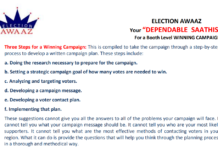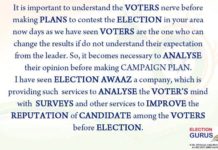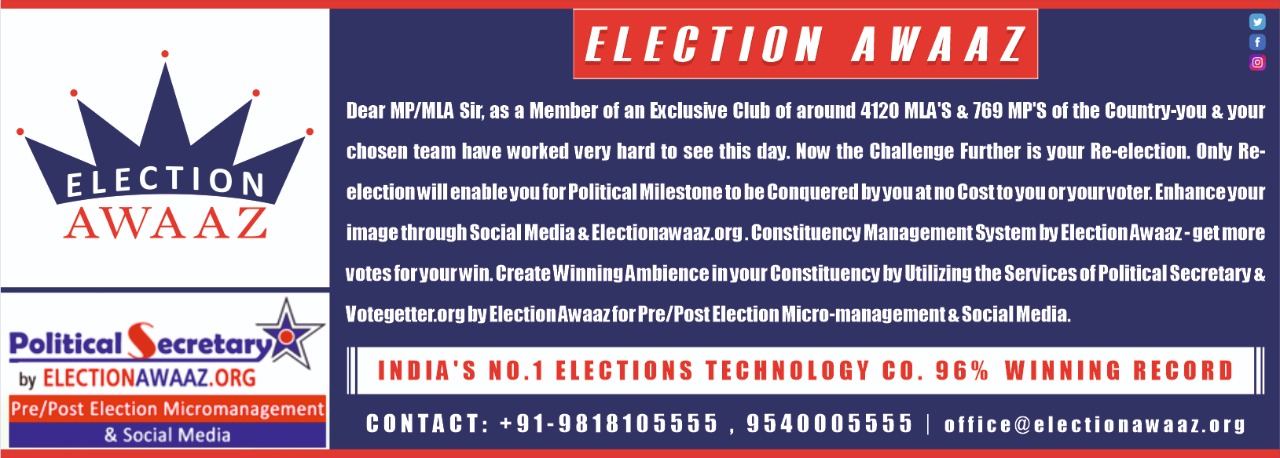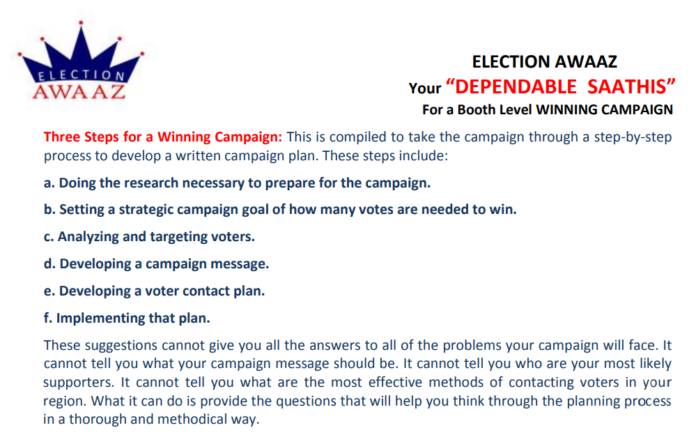Three Steps for a Winning Campaign: This is compiled to take the campaign through a step-by-step process to develop a written campaign plan. These steps include:
a. Doing the research necessary to prepare for the campaign.
b. Setting a strategic campaign goal of how many votes are needed to win.
c. Analyzing and targeting voters.
d. Developing a campaign message.
e. Developing a voter contact plan.
f. Implementing that plan.
These suggestions cannot give you all the answers to all of the problems your campaign will face. It cannot tell you what your campaign message should be. It cannot tell you who are your most likely supporters. It cannot tell you what are the most effective methods of contacting voters in your region. What it can do is provide the questions that will help you think through the planning process in a thorough and methodical way.
Therefore, the candidate, the campaign manager, and all the key advisers should conduct a strategic planning meeting and go through these points seriously and rigorously. Your strategic planning session should also result in a written campaign plan. Too often, politicians believe that they hold the winning strategy “in their heads.” In reality they have no strategy at all and are wandering aimlessly. Too often the candidate and the campaign manager believe that they are following a single strategy, only to find out later that their opinions about the strategy are completely at odds. A written campaign plan, agreed upon by the candidate, the campaign manager, and all the key advisors, would help avoid such problems. The rule is simple – if a plan is not written down, no plan exists.
Once you have the written plan, you must follow that plan in a disciplined way. As with any plan, it is only as good as its implementation. All campaigns must be flexible to changing circumstances, but these changes should be carefully considered and weighed against the original research and strategy laid out in the plan.
A political campaign is an intense experience and, when done correctly, it is also a lot of hard work. There are no tricks or short cuts to winning the confidence of the voters. A political campaign can also be an exhilarating, rewarding and fun experience. To the campaign workers, you should be commended for offering you time and skills to improve the general situation and make democracy work. To the candidates, you should be commended for stepping forward and offering your services to your community. In doing so you not only serve your community, you are contributing to the democratic process as a whole.
STEP ONE: RESEARCH
Every campaign is different and unique. While certain basic principles can be applied to each campaign, it is important to have a complete understanding of the particular situation and the conditions in which your campaign will be waged. At some point in almost every campaign, someone says, “it is different here” or “you’re not taking into account our particular situation.”
“Step One: Research” is where you start and where you take into account the differences and peculiarities of each campaign. It is here that you have the chance to demonstrate just how different your situation really is.
ELECTION AWAAZ
Your “DEPENDABLE SAATHIS”
For a Booth Level WINNING CAMPAIGN
The first step in developing a winning strategy must begin with a realistic assessment of the political landscape in which you will be running. It is true that you can never know everything about your Constituency, your opponents and the voters. However, by using your time wisely and setting clear priorities, you will be able to compile the kind of information you need to develop a good strategy and be prepared for most events in the coming campaign. There are a number of factors that should be understood as completely as possible as you prepare to write a campaign plan:
1. What is the type of election and what are the rules?
2. What are the characteristics of the Constituency?
3. What are the characteristics of the voters?
4. What has happened in past elections?
5. What are the main factors affecting this election?
6. What are the strengths and weaknesses of your candidate?
7. What are the strengths and weaknesses of all the viable opponent?
It is important for the campaign team to take some time to research the answers to as many of these questions as possible. If you have a large, reliable campaign team, you may want to assign different sections to different members of the team. They can then report their findings to the campaign manager who will be responsible for writing the final campaign plan. Either alone or as a team, it is important that you set and stick to a time limit for doing the research. There will always be more information you can gather, but this will only delay the use of the information you already have in developing your strategy. In some cases, this type of research may benefit from more scientific methods of obtaining the data, such as political polling or focus groups. You will need to determine what resources are available to you and whether they are worth the expense of time and/or money.
In small, local races paying for a poll could cost as much as the whole campaign and therefore should not be considered. On a larger campaign where thousands of dollars will be spent on advertising, you would be foolish not to spend a fraction of that amount to see if the message of that advertising will work. ELECTION RULES It is important to first determine the type of election in which you will be running and what will be the rules of the election. Much of the basic strategy depends on this information. Is this a legislative office you are seeking or an executive office? Do you need a majority of the votes to win or a plurality? Will there be a runoff election? You should definitely research the laws and, if they are complicated, you may want to ask your political party or a lawyer to draft a memo outlining the most important points. Missing a deadline or violating some part of the law could end your campaign before it has even begun.
ELECTION AWAAZ
Your “DEPENDABLE SAATHIS”
For a Booth Level WINNING CAMPAIGN
THE CONSTITUENCY
Once you have determined the basic election rules, you should start to gather as much information on the Constituency and the voters as possible. How large is the Constituency in which you will be running? What type of terrain will you have to cover as you campaign? What type of transportation will you and the voters need to use? How has the population of the Constituency changed recently? You need to understand the political landscape in which you will be operating. Who are the important political players in the area? How strong are the various political parties in the area? Who are the civic and business leaders that can influence the campaign? Winning the support of a particularly influential leader in the community can often make the campaign much easier. You also must understand how voters get their information. What are the local media outlets? Who are the reporters and what are their deadlines? How will the election be covered and how does the press view the various candidates? To develop a comprehensive press strategy, it is important to have as much information on the media as possible.
THE VOTERS You will need to break the voters in your Constituency into manageable groups. This is the basis you will later use to develop a strategy for targeting particular voters. The following are some of the questions you may want to consider. Is there a voter file or accurate list of all possible voters available to the campaign? What support is there for various political parties? What is the demographic composition of the voters? For example, what are the income levels, education levels, professions, ethnic backgrounds, religious backgrounds, age, gender, etc.? Where do people work, shop and play? What is the geographic break down of the voters? What percentage or how many people live in the city, in the rural areas or in small villages? Do the voters live in single-family homes or apartments? How would you describe your supporters and those voters you hope to persuade? Voters with similar characteristics may have similar interests and may tend to vote the same way. Seniors will be less interested in schools and more interested in pensions while young mothers will be more interested in schools and less interested in pensions. By determining how many senior citizens there are and how many young mothers there are, you will be better able to target your message to groups that matter to your success.
PAST ELECTIONS
Often you can gain valuable information about this election by looking at information from past elections. Who ran for this position in your Constituency in past elections and what were the results? How many voters turned out for similar elections in the past? How many votes were needed to win? You may be able to use this type of information to predict the turnout and baseline levels of support in this election. How did candidates with similar backgrounds and messages fair in past elections? You will want this type of information later when you determine what worked for them and what you will have to do differently to do better than they did.
THIS ELECTION
Next you should look at the factors that will affect this election, namely the various issues that concern voters and other political campaigns, which are being waged in the area. What local, regional or national issues are important to voters? What will motivate voters to go to the polls?
How would you describe the voter mood?
What other races will be on the same ballot? Will candidates in other races help or hurt your campaign? Is there the opportunity to work with other campaigns in a coordinated manner? What effect will other campaigns have on the election? Your relationship with your party and other candidates on the same ticket will affect your strategy. Your campaign’s message should complement, or at least not contradict, the other messages.
ELECTION AWAAZ
Your “DEPENDABLE SAATHIS”
For a Booth Level WINNING CAMPAIGN
OUR CANDIDATE
The most important factor in your election will be the candidate. During your strategic planning session, you should honestly and candidly judge the strengths and weaknesses of your candidate. As you do this exercise, you should also look at your candidate from the point of view of your opponent. What you may view as a fresh new face with new ideas, your opponent may view as a lack of experience.
You may want to organize your assessment into various sections, such as the candidate’s childhood, education, work history, immediate family, and past political positions.
It is important to look for both strengths and weaknesses in all of these areas. By finding weaknesses early, the campaign will be better prepared to deal with them and respond to charges that may come up later in the campaign. Too many candidates have lost because they refused to deal with past mistakes and were caught off guard when their opponents painted the picture of their mistakes in a very unflattering light.
VIABLE OPPONENTS
Once you have determined your own candidate’s strengths and weaknesses, the next logical step is to repeat the process for your opponents’. If you are facing several opponents, you should determine which are your strongest competitors for the loyalty of voters you hope to attract. Again, you can organize your assessment into various sections and look for both strengths and weaknesses.
Your opponents will not be forthcoming with information about themselves. You will probably need to do some digging to find reasons for voters to vote against them and for your candidate.
Too often candidates and campaigns view opposition research as looking for the one scandal that will finish off their opponent’s campaign. This may happen, but more often what you find is patterns of behavior that you can use to persuade voters to either vote against your opponent or for you. You will use this to create a contrast between your candidate and campaign and your opponents’ campaign when you develop your message, but this process is the basis for finding that contrast.
The other mistake campaigns often make, is saying that they do not want to wage a negative campaign. Researching your opponent and waging a negative campaign are two entirely different things. By not taking the time and doing the hard work of opposition research, you forfeit the ability to be prepared for what your opponent will say and do and to build the contrast between yourself and your opponent.
As you gather your opposition research, you must be extremely well organized: list the sources of your documentation, and have a system in place that will allow you to quickly access the information. It will do no good to know something and not be able to provide backup of the information. All of this research should be gathered together in a binder for easy referral and referenced for easy tracking. Being meticulous and organized now will save a lot of time and energy later.
ELECTION AWAAZ
Your “DEPENDABLE SAATHIS”
For a Booth Level WINNING CAMPAIGN
STEP TWO: SETTING A GOAL
The ultimate goal of almost every political campaign is to win elected office. What you need to do here is determine what must be done to achieve that victory. Too often campaigns forget to calculate how many votes will be needed to guarantee victory and determining where these votes will come from. They then spend their precious resources of time, money and people trying to talk to the whole population instead of the much fewer voters they will need to win. Here you will reduce the number of voters with whom you need to communicate to a much more manageable size. As part of your research, you should determine the total population of your Constituency, the total number of voters, the expected votes cast, the number of votes needed to win and the number of households in which these voters live. Some of the answers that are needed here require you to look into the future and make some educated guesses. Use your best judgment and the information you have found from past elections.
WHAT IS THE TOTAL POPULATION OF THE CONSTITUENCY?
“Total population” is all the people who live in your Constituency. Considering children too young to vote and people not registered in the Constituency, this number should be larger than the total number of voters.
WHAT IS THE TOTAL NUMBER OF VOTERS?
“Total number of voters” is all the voters in the Constituency who are eligible to vote and can possibly vote in this election.
WHAT IS THE EXPECTED TURNOUT?
“Expected turnout ” is the expected votes cast in this election. Not every voter will vote. Often you can determine how many voters will vote by looking at past similar elections. If there was 35% turn out in the last city election and there are no added factors this time to change the situation, you might figure that about 35% would vote in the city election this time. If on the other hand, there was a 55% turn out in the Parliamentary election and this time the city election is combined with the Parliamentary election, you may want to estimate that 55% will turn out this time.
HOW MANY VOTES ARE NEEDED TO WIN?
This is a very speculative number. What you are looking for is the total number of votes needed to guarantee victory in your race. If you need a majority of the votes to win, this would be 50% of turnout plus one vote. In many cases you only need a plurality of the votes cast or more votes for your candidate than any other candidate in the race receives. In the case of multi-candidate races, you may be able to win with 35%, 30%, 25% or less of the vote. It is important to convert this percentage to a real number. How many actual votes will guarantee your victory? You should be conservative and error on the side of too many votes rather than too few.
HOW MANY HOUSEHOLDS DO THESE VOTERS LIVE IN?
You can reduce this group yet again. On average, let us say that there are two voters per household. Some families may have three or four voters living in the same house. Some voters may be single and live alone. Now, if you think that a husband and wife are likely to vote the same way, you can often assume that if you talk to one member of the family than you can expect to get the second vote. So, how many households will you need to communicate with to receive the number of votes needed to win?
BRINGING IT ALL TOGETHER
How does all this come together? Let us say that your Constituency has a population of 130,000 people. Of this population, there are 30,000 children below voting age and other non-registered voters, leaving a total number of 100,000 voters. In the last city election, there was 50% turnout of voters, or 50,000 votes cast. You assume it will be the same this time. In a multi-candidate race for city council, the winning candidate received 34% of the vote or 17,000 votes cast. If you figure an average of two voters per household, this would come to 8,500 households.
ELECTION AWAAZ
Your “DEPENDABLE SAATHIS”
For a Booth Level WINNING CAMPAIGN
Now, you cannot assume that every voter you talk with will be persuaded to vote for you. So you should figure to communicating with a larger number of voters in order to receive the votes from 17,000 voters or 8,500 households. Suppose you persuade seven out of every 10 voters you communicate with to vote for you. You will need to talk to 25,000 voters or 13,000 households in order to be assured of support from 17,000 voters or 8,500 households (25,000 x 0.7 = 17,500 and 13,000 x 0.7 = 9,100). It is still a lot easier to talk with and try to persuade 13,000 families than it is to talk to and try and persuade 100,000 people. This whole process is narrowing the group of people you need to persuade down to a much smaller size.
: SETTING A CAMPAIGN GOAL
Using your research information and your best judgment, answer the following questions and incorporate the answers into your written campaign plan:
1. How many people (not just voters) live in your Constituency?
2. How many of these people are able to vote in this election?
3. What percentage of these voters do you expect to vote in this election?
4. How many expected voters is this in real numbers?
5. How many candidates will be running for this position?
6. How many of these candidates could be considered serious?
7. If the election were held today, what percentage of the vote do you think each candidate would receive?
8. What percentage of the votes cast will be needed to win?
9. How many are votes cast in real numbers needed to win?
10. On average, how many voters live in one household?
11. Do these voters living in the same household all tend to vote for the same candidate?
12. If they do tend to vote for the same candidate, how many households will you need to receive the support of to guarantee victory?
13. If you talk to ten average voters, how many can you persuade to vote for you?
14. How many households will you need to communicate with for your message to reach enough voters to achieve victory?
STEP THREE: TARGETING THE VOTERS
WHAT IS TARGETING?
Once you decide how many votes you need to win and, therefore how many voters you need to persuade to support your candidate, you need to determine what makes these voters different from other voters who will not support your candidate. This process is called “targeting the voters” or simply “targeting.” The point of targeting is to determine which subsets of the voting population are most likely to be responsive to your candidate and focusing your campaign efforts on these groups of voters. You will remember when you worked on “Step One: Research,” you were asked to break voters down into more manageable groups. It was said then that you would use this information when you targeted particular voters. That time has come.
ELECTION AWAAZ
Your “DEPENDABLE SAATHIS”
For a Booth Level WINNING CAMPAIGN
WHY TARGET VOTERS?
Targeting is important for two reasons. First, you want to conserve those precious campaign resources of time, money and people, and second, you want to develop a message that will best persuade those voters you still need to convince to vote for you. CONSERVING CAMPAIGN RESOURCES If you develop literature for everyone in the Constituency and try to shake the hand of every voter in the Constituency, then you are wasting a lot of money and a lot of time on people who will not vote for you no matter what you say or do. If, on the other hand, you can identify a smaller but significant group of voters who will most likely be persuaded by your campaign message. You will then be able concentrate your efforts on them and you will have more resources to repeat your message over and over again, until it seems that they have no choice but to vote for your candidate. Suppose, for example, that you decide that you need to communicate with 33% of the voters to win. If you could identify exactly which voters were most likely to deliver that 33%, then your campaign could reach them with one-third of the resources that you would need for an untargeted campaign. Put another way, if your campaign had the resources to reach every voter in the Constituency one time, you could instead target your efforts to reach your most likely supporters three times. Candidates that do not take the time to target their voters have lost the right to complain about scarce campaign resources.
PERSUADING TARGET VOTERS
In the next section, a good bit of time will be spent discussing your campaign message. Before that , however, you need to determine who the best audience for that message will be. This will help you determine what you can say that is likely to persuade them. An important rule to remember is that as a party or candidate tries to reach a broader and broader audience, then that party’s or candidate’s message becomes defused and weaker for each part of that audience. Ultimately, the party or candidate that promises everything to everybody has an empty message that no voter will find credible or compelling. The goal of targeting, therefore, should be to focus your campaign effort on a range of voters that can deliver approximately the same number of votes that you set as your campaign goal in Step Two. If your target audience is too narrow, you will not attract enough votes to win. If your target audience is too broad, your message will become diffused, and candidates with better focus will steal parts of the message – and the electorate – from you. Generally speaking, there are three types of voters: your supporters, your opponents’ supporters and those voters in the middle who have yet to make up their minds. Your supporters are those who have already decided to vote for you. Your opponents’ supporters are those who have already decided to vote for your opponents. Those voters in the middle who have not yet decided and still need to be persuaded to vote for one or the other candidates are called persuadable voters. It is some portion of these persuadable voters whom you want to target and with whom you want to communicate your message. Remember that a political campaign is a communication process. HOW TO TARGET VOTERS Once you have determined that you need to persuade only about half of the electorate or less to vote for your candidate, you need to figure out what makes your potential voters different from the others. There are two ways to determine this: geographic targeting and demographic targeting. Most campaigns will use some combination of both methods.
ELECTION AWAAZ
Your “DEPENDABLE SAATHIS”
For a Booth Level WINNING CAMPAIGN
GEOGRAPHIC TARGETING
Geographic targeting is simply determining who will vote for your candidate based on where they live. For example, let us say that candidate “A” lives in town “A” and is well known and liked by her neighbors. Candidate “B” lives in town “B” and is well known and liked by his neighbors. Most of candidate “A’s” supporters are going to come from town “A” and she needs to go to town “C” to persuade those residents who are not already committed to a candidate in the race that she is the best candidate. She would be foolish and wasting her time to go to town “B” and try to persuade those residents and neighbors of candidate “B” to vote for her. This is a very simple example, though there are elections where the targeting is that easy. More often the campaign will have to look at past elections to determine past performance, the persuadability of the voters and the expected turnout. This can best be done where data can be obtained for past elections down to the precinct level. Past performance is the percentage of votes that your candidate, your party or a similar candidate received in past elections. Precincts with high performance contain your most likely supporters. In theory, a campaign should not spend resources on very high-performance precincts; after all, it makes little sense to try to persuade voters who will already vote for you. However, most candidates should some spend resources in areas with a history of voting for democratic candidates and parties in order to solidify their base of support before reaching out to other potential supporters. The persuadability of voters is the percentage of voters in a precinct that do not vote in a consistent way. It is the difference in percentage of votes for similar candidates either in the same election or two consecutive elections. Voters either “split” their vote (vote for candidates of different orientations in the same election) or “shift” their vote (vote for candidates of different orientations over the course of two or more elections). It is generally considered that “vote splitters” and the “vote shifters” are the voters most likely to be persuaded by a campaign’s efforts. Because of this, most campaigns spend the majority of their effort – posters, door to door, etc. – in precincts with high persuadability. This strategy makes sense. Expected turnout can be determined by the percentage of voters who turned out in the most recent similar election. It makes no sense to spend campaign resources on people who will not vote, so your campaign should spend more resources on precincts with a history of higher turnout.














